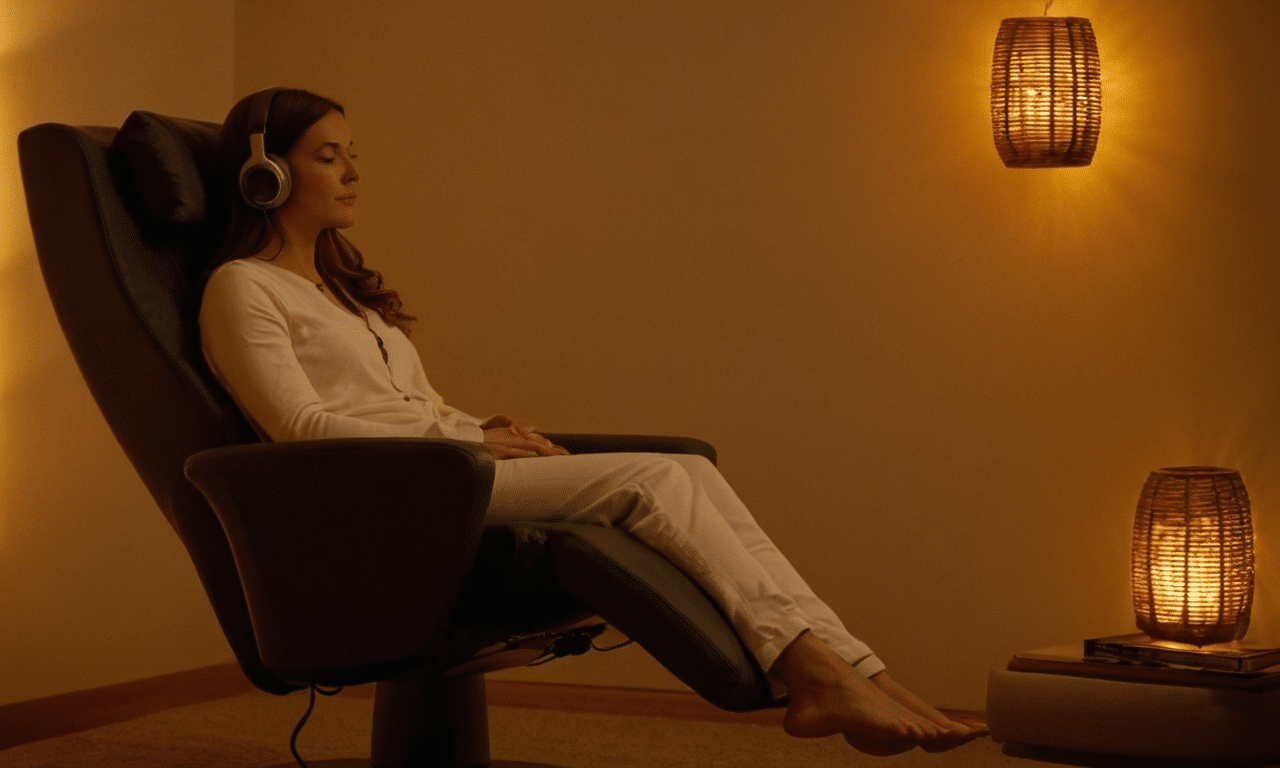Sound therapy has become increasingly popular as a means to promote relaxation and reduce stress. But what exactly is sound therapy, and how does a sound therapy chair fit into this process? We’ll explore the benefits of these chairs, the types available, and provide guidance on choosing the right one for you.
What are the benefits of using sound therapy chairs?
Sound therapy chairs offer a range of benefits, including enhanced relaxation and stress relief through immersive sound experiences, improved focus and concentration, and increased sensory stimulation for individuals with sensory processing disorders or autism. They can also facilitate deeper meditation and yoga practices by creating a conducive environment for mindfulness.
Top Features of Sound Therapy Chairs
- Soothing sound waves for relaxation and stress relief.
- Vibrations that mimic a gentle massage, easing muscle tension.
- Customizable settings to tailor the experience to your needs.
- Built-in speakers or Bluetooth connectivity for seamless integration.
- Adjustable volume levels to ensure comfortable listening experiences.
- Pre-programmed sessions designed by experts to target specific benefits.

Benefits of Sound Therapy Chairs
Sound therapy chairs offer a unique way to relax by utilizing sound waves to improve mental well-being. These chairs provide a sensory experience that aids individuals in achieving a state of calm and tranquility. By targeting specific frequencies, the sound waves aim to reduce stress and anxiety levels effectively.
One of the remarkable benefits is how sound therapy chairs help balance emotional states. Regular use can result in heightened mood and mental clarity. For more information on how sound therapy works, explore our detailed articles on the subject.
Another advantage is the improvement in sleep quality. The soothing vibrations and harmonious tones can make it easier to fall and stay asleep. With better sleep, individuals often report increases in productivity and overall life satisfaction. Ah, who could say no to that?
Types of Sound Therapy Chairs Available
The market offers several types of sound therapy chairs, each catering to different needs. One popular option is the vibroacoustic therapy chair. These chairs use low-frequency sounds to produce therapeutic vibrations, creating a calming effect that resonates throughout the body.
Another type is the sound wave chair, which combines audio therapy with a comfortable seating arrangement. By emitting specific sound frequencies, these chairs provide a holistic approach to wellness. The experience often feels like getting a massage for your mind. Yes, please.
Let’s not forget the musical therapy chair. These chairs incorporate music-based healing techniques, channeling musical notes to improve well-being. They usually come with built-in speakers, making it easy to integrate with your personal playlists. For information on other relaxation techniques, don’t miss our comprehensive guides.
Choosing the Right Sound Therapy Chair for You
When selecting a sound therapy chair, consider what benefits you’re hoping to gain. Are you looking for stress relief, improved sleep, or enhanced focus? Understanding your specific needs will help you narrow down the many options available on the market.
Pay attention to the features each chair offers. Some models come with adjustable settings, allowing you to customize the experience to your liking. Others offer pre-programmed sessions designed by experts. Choosing a chair that aligns with your preferences is essential for long-lasting use.
Don’t forget to consider the chair’s compatibility with your existing sound equipment. Some models are Bluetooth-enabled, while others might require specific audio devices. For detailed advice on what to look for in sound therapy, check out our specialized content. After all, it’s not just a chair; it’s a lifestyle investment.
Additional Considerations When Using a Sound Therapy Chair
Incorporating a sound therapy chair into your daily routine doesn’t have to be complicated. Set aside specific times each day for your sessions. Many find early mornings or late evenings to be most effective. Consistency is vital to reaping the long-term benefits of sound therapy.
Take note of your posture while using the chair. Ensuring you’re comfortably seated can enhance the effectiveness of the therapy. Make adjustments as needed to find the most relaxing position. For more on maintaining good posture, our related articles offer valuable tips.
Finally, be mindful of volume levels. While the aim is to relax, excessively loud sounds can do quite the opposite. Start at lower settings and gradually increase until you find a level that suits you. Effective relaxation techniques can augment your sound therapy experience, making it even more beneficial.
| Feature | Description | Importance |
|---|---|---|
| Benefits of Sound Therapy Chairs | Reduces stress and anxiety, improves sleep quality, and enhances mood. | High |
| Types of Sound Therapy Chairs Available | Vibroacoustic, sound wave, and musical therapy chairs cater to different needs. | Medium |
| Choosing the Right Sound Therapy Chair for You | Consider your specific needs and preferences when selecting a chair. | High |
| Incorporating a Sound Therapy Chair into Your Daily Routine | Set aside specific times each day for consistent use. | Medium |
| Maintenance Tips for Your Sound Therapy Chair | Adjust volume levels and ensure comfortable seating to enhance effectiveness. | Low |
Personal Thoughts
I’ve found that sound therapy chairs can be a valuable tool for managing stress and anxiety. In my own life, I’ve struggled with chronic stress and have tried various methods to cope.
As someone who has experienced the negative effects of unchecked stress, I believe that finding ways to manage it is crucial. The sound therapy chair has been one such method that has helped me relax and reduce my overall stress levels. It’s a simple yet effective way to take a step back from the chaos and focus on my well-being.
Frequently Asked Questions
What is a sound therapy chair designed to do?
A sound therapy chair is specifically designed to facilitate the use of sound waves as a form of therapy. It provides an immersive and comfortable environment for individuals to receive sound-based treatments, such as binaural beats or ASMR sessions.
How does a sound therapy chair work with sound therapy techniques?
A sound therapy chair typically comes equipped with speakers or transducers that emit specific frequencies and patterns of sound, which are tailored to the individual’s needs. The chair can also be designed to provide gentle vibrations, tactile stimulation, or other sensory experiences to enhance the therapeutic effects.
Are sound therapy chairs only used for relaxation purposes?
No, sound therapy chairs can be used for a wide range of therapeutic applications beyond relaxation. They can help individuals with anxiety, insomnia, PTSD, and other conditions by providing targeted sound-based treatments that address specific symptoms and needs.
Can I use my own sound therapy chair at home or is it only suitable for professional settings?
Sound therapy chairs are designed to be used in a variety of settings, including homes, offices, and professional treatment centers. They can be easily integrated into daily routines and can be used by individuals seeking self-care, professionals offering sound-based therapies, or healthcare providers looking to expand their treatment options.




